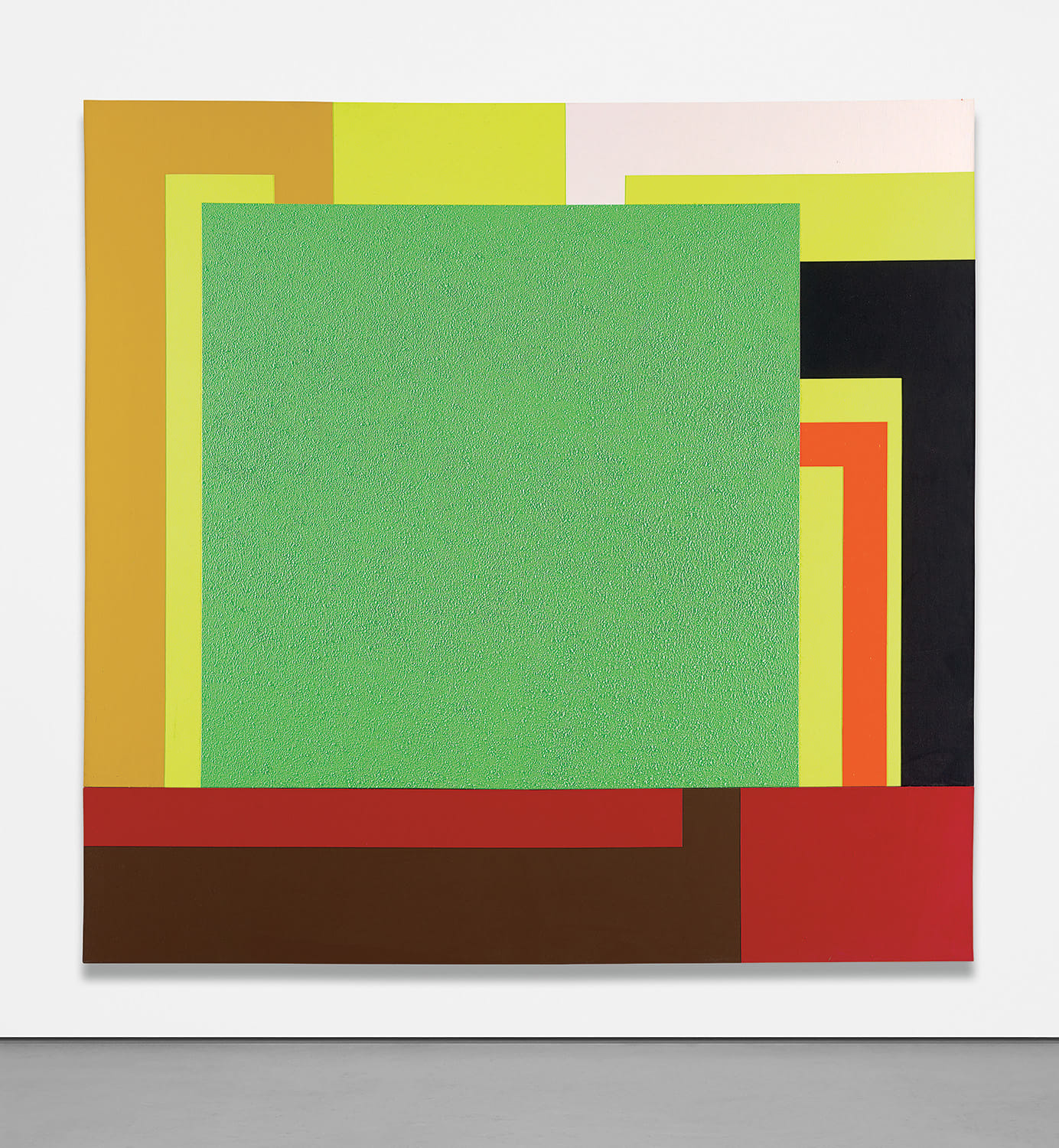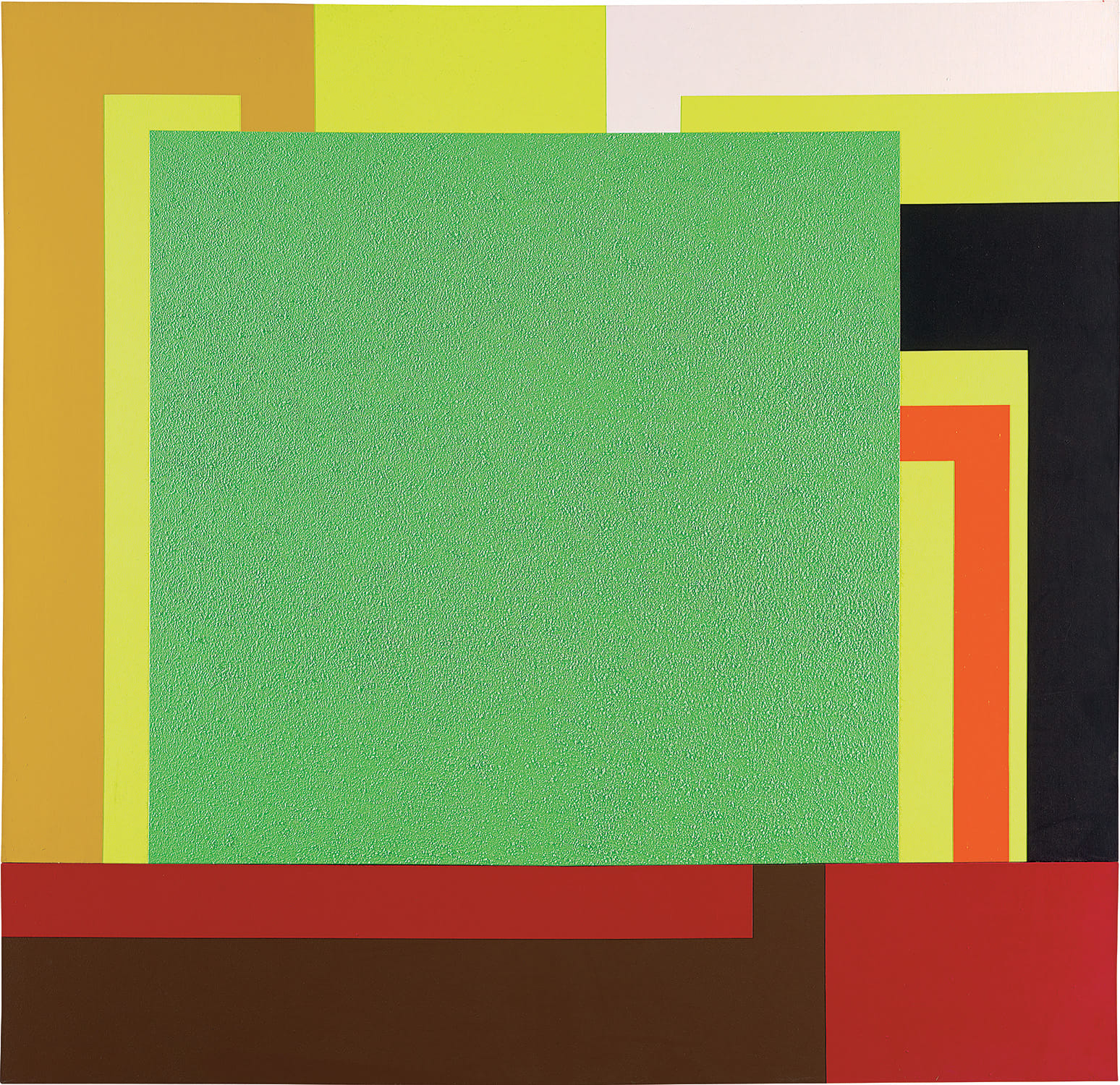



Property from a Distinguished Midwestern Collection
353
Peter Halley
303
acrylic, fluorescent acrylic and Roll-a-Tex on canvas, in 2 parts
88 1/2 x 91 1/2 in. (224.8 x 232.4 cm.)
Executed in 1991.
Full-Cataloguing
“My images seem, step by step, to have grown more complex and fast-paced in a way that somehow parallels the acceleration of the movement and information in the new computer culture…I take great pleasure in the idea that my work could be a mirror of this era of change.” – Peter Halley
A monumental network of interconnected cells, Peter Halley’s 303, 1991, is a powerful display of postmodern geometric abstraction rendered in the artist’s signature Roll-a-Tex medium and fluorescent hues. Included in the artist’s seminal traveling retrospective in Europe the same year as its execution, 303 exemplifies Halley’s rigorous formal language and bold aesthetic, engrained with cynicism, irony and, at times, humorous wit. Profoundly inspired by New York’s intense urban environment and the burgeoning flow of information generated by computer technology during the 1980s, Halley conceived of a formal vocabulary of squares, rectangles and bars as coded referents to the ways in which geometry pervades modern life. For Halley, a square symbolizes a cell or prison; a rectangle represents an office tower or high-rise apartment building; and a series of bars or lines signifies the urban grid. An acutely cynical approach to these late capitalist structures, Halley’s compositions serve as metaphors for the isolating effects of these modern developments recast as zones of confinement.
Building upon the vocabularies of Minimalism, Color Field painting and Constructivism, Halley defies such categorizations in his endeavor to place content back into formalism. Informed by the writings of French philosopher and social theorist Paul-Michel Foucault, he considers his paintings to be referential rather than abstract, actively questioning the supposed neutrality of traditional modes of abstraction. In 303, a neon green square dominates the composition – a nucleus from which a network of conduits enters from every direction. The increasing visual complexity of these early 1990s paintings evokes a plethora of references to our postmodern age: “a diagram of a microprocessor plugged into a circuit board; a hospital patient attached to drips and monitors; a swinger seeking polymorphous satisfaction” (Pepe Karmel, Conceptual Abstraction, New York, 2012, p. 30).
Executed in textured Roll-a-Tex, Halley’s ready-made parody of painterly impasto, 303 takes on a distinct architectural quality, amplified by the geometric, structural rigidity of the composition. Reminiscent of the ceiling of a suburban motel or hospital clinic, this stucco surface evokes a sense of manufactured artifice consistent with Halley’s critique of late 20th century society. In 303, this architectural rendering of the square – previously a symbol of transcendence and avant-garde aspiration for artist’s such as Kazimir Malevich – is ultimately transformed into a physical and literal site of imprisonment and social isolation.
Despite its misanthropic undertones, 303 belongs to a period of artistic liberation and exploration for Halley. In an interview with art critic and curator Kathryn Hixson in 1991, he explains: “I think of the new paintings as much more verbal, they are more about motion. They are about being in the space rather than looking at a picture of it. They give me the feeling of rushing around in that space, of flowing through it rather than looking at a diagram of that flow” (Peter Halley, quoted in Kathryn Hixson, “Interview with Peter Halley”, Peter Halley, exh. cat., FAE Musée d'Art Contemporain, Pully/Lausanne, 1992, p. 28). In 303, the sense of movement is palpable, as the pulsing hues and dizzying network of conduits mimic the very feeling of “rushing around” in space. Previously saturated with an undeniable skepticism, these early 1990s paintings breathed new life into Halley’s practice. He notes, “The crisis of my public identity came to a head in ‘88 or ‘89. At that time, I think, the work underwent a profound change. I came out of that period with a very liberating sense of being in a marvelously absurd position. I gained a sense of play about my own position, and about the subject matter I was dealing with, and that really began to affect the work…I began to think it was funny rather than depressing” (Peter Halley, quoted in Kathryn Hixson, “Interview with Peter Halley”, Peter Halley, exh. cat., FAE Musée d'Art Contemporain, Pully/Lausanne, 1992, p. 26). Indeed, 303 is “marvelously absurd” – equal parts playful and cynical, humorous and critical, this masterful example embodies the iconic brand of geometric abstraction for which Halley is so renowned today.
A monumental network of interconnected cells, Peter Halley’s 303, 1991, is a powerful display of postmodern geometric abstraction rendered in the artist’s signature Roll-a-Tex medium and fluorescent hues. Included in the artist’s seminal traveling retrospective in Europe the same year as its execution, 303 exemplifies Halley’s rigorous formal language and bold aesthetic, engrained with cynicism, irony and, at times, humorous wit. Profoundly inspired by New York’s intense urban environment and the burgeoning flow of information generated by computer technology during the 1980s, Halley conceived of a formal vocabulary of squares, rectangles and bars as coded referents to the ways in which geometry pervades modern life. For Halley, a square symbolizes a cell or prison; a rectangle represents an office tower or high-rise apartment building; and a series of bars or lines signifies the urban grid. An acutely cynical approach to these late capitalist structures, Halley’s compositions serve as metaphors for the isolating effects of these modern developments recast as zones of confinement.
Building upon the vocabularies of Minimalism, Color Field painting and Constructivism, Halley defies such categorizations in his endeavor to place content back into formalism. Informed by the writings of French philosopher and social theorist Paul-Michel Foucault, he considers his paintings to be referential rather than abstract, actively questioning the supposed neutrality of traditional modes of abstraction. In 303, a neon green square dominates the composition – a nucleus from which a network of conduits enters from every direction. The increasing visual complexity of these early 1990s paintings evokes a plethora of references to our postmodern age: “a diagram of a microprocessor plugged into a circuit board; a hospital patient attached to drips and monitors; a swinger seeking polymorphous satisfaction” (Pepe Karmel, Conceptual Abstraction, New York, 2012, p. 30).
Executed in textured Roll-a-Tex, Halley’s ready-made parody of painterly impasto, 303 takes on a distinct architectural quality, amplified by the geometric, structural rigidity of the composition. Reminiscent of the ceiling of a suburban motel or hospital clinic, this stucco surface evokes a sense of manufactured artifice consistent with Halley’s critique of late 20th century society. In 303, this architectural rendering of the square – previously a symbol of transcendence and avant-garde aspiration for artist’s such as Kazimir Malevich – is ultimately transformed into a physical and literal site of imprisonment and social isolation.
Despite its misanthropic undertones, 303 belongs to a period of artistic liberation and exploration for Halley. In an interview with art critic and curator Kathryn Hixson in 1991, he explains: “I think of the new paintings as much more verbal, they are more about motion. They are about being in the space rather than looking at a picture of it. They give me the feeling of rushing around in that space, of flowing through it rather than looking at a diagram of that flow” (Peter Halley, quoted in Kathryn Hixson, “Interview with Peter Halley”, Peter Halley, exh. cat., FAE Musée d'Art Contemporain, Pully/Lausanne, 1992, p. 28). In 303, the sense of movement is palpable, as the pulsing hues and dizzying network of conduits mimic the very feeling of “rushing around” in space. Previously saturated with an undeniable skepticism, these early 1990s paintings breathed new life into Halley’s practice. He notes, “The crisis of my public identity came to a head in ‘88 or ‘89. At that time, I think, the work underwent a profound change. I came out of that period with a very liberating sense of being in a marvelously absurd position. I gained a sense of play about my own position, and about the subject matter I was dealing with, and that really began to affect the work…I began to think it was funny rather than depressing” (Peter Halley, quoted in Kathryn Hixson, “Interview with Peter Halley”, Peter Halley, exh. cat., FAE Musée d'Art Contemporain, Pully/Lausanne, 1992, p. 26). Indeed, 303 is “marvelously absurd” – equal parts playful and cynical, humorous and critical, this masterful example embodies the iconic brand of geometric abstraction for which Halley is so renowned today.